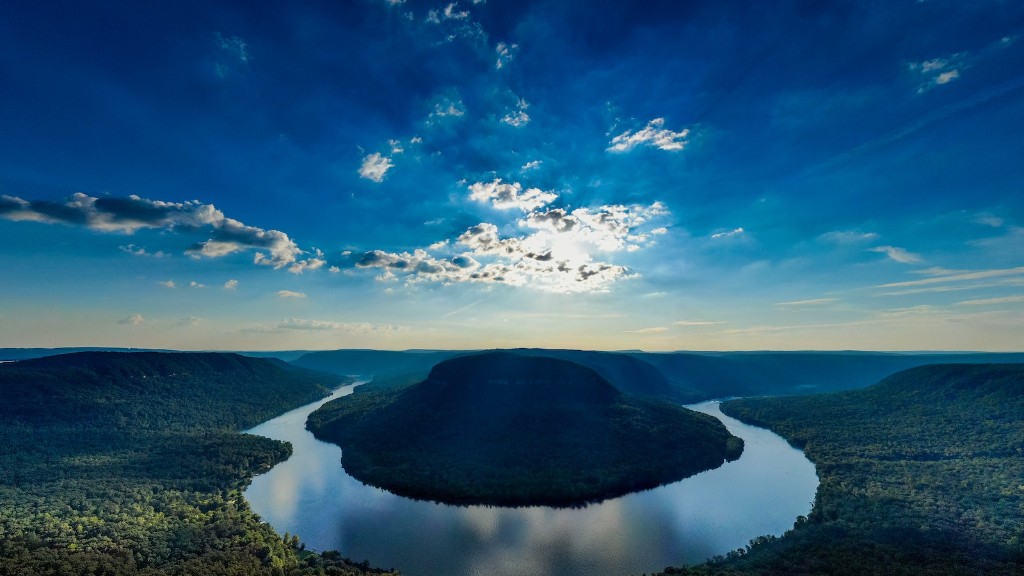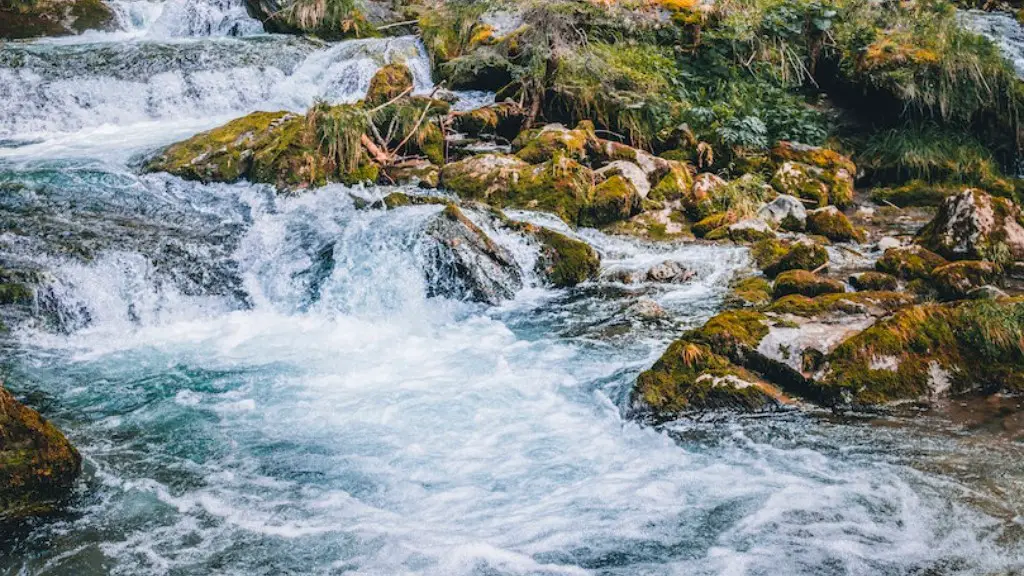The Length of the Nile River
The Nile River has been an important source of sustenance and transport to the people of North Africa for thousands of years. Spanning an incredible 6650 kilometers, the Nile River is one of the longest rivers in the world. It passes through 10 countries, beginning in Burundi, flowing northward through Uganda, Sudan and Egypt before draining into the Mediterranean Sea.
The Nile flows across a varied geographical region of lush, grassy plains, desert and rainforest. In certain areas it forms lakes and wetlands, while in others it floods and waters arable land. Along its banks are some of the most impressive ancient structures, such as the Great Pyramids of Giza and the Sphinx.
The river has two distinct parts – the White Nile and the Blue Nile. The White Nile originates in Lake Victoria and is relatively shallow, slower-moving and flows northwards. The Blue Nile starts in the Ethiopian highlands and flows rapidly through steep gorges. The meeting of the two produces Egypt’s Nile Delta and provides much of Egypt’s most fertile land.
The steadily moving water provides ideal conditions for navigation and water transport. This has been a major factor in the rise of Egypt’s Old Kingdom and Nubian civilizations. For centuries, Egypt flourished due to the river’s fertility, providing essential food and materials for economic growth. Currently, many Egyptians depend on the river, utilizing it for drinking water, fishing, bathing, washing and trading.
Today, the Nile River and the region is heavily dependent on climate change and on the flow of water from Ethiopia. Recently, Ethiopia has become the source of much debate, over the possibility of diverting water from the Blue Nile. After years of disputes, the issues have still yet to be resolved, meaning that the fate of the Nile River remains uncertain.
In more recent years, demand for water has increased due to urban expansion, agricultural irrigation and industrial activities. Pollution of the river and its tributaries has also become a serious issue. Overfishing and dredging by people living in the Nile basin is also a major threat. Despite this, the Nile remains one of the longest and widest rivers in the world.
The Impact of Climate Change on the Nile
Climate change has had a profound effect on the Nile River. In recent decades, temperatures in the region have risen, leading to less rainfall in some areas, with more erratic rainfalls in others. This has resulted in less water flowing further downstream. Furthermore, the melting of glaciers in the Ruwenzori Mountains (located in Uganda, Tanzania and the Democratic Republic of Congo) has also caused changes in the river’s water levels.
These changes are affecting the livelihoods of many people in the region. With decreased water levels, more frequent droughts and increased temperatures, many farmers are struggling. The lack of water is also making it difficult for people to access clean drinking water, leading to water-borne diseases. Furthermore, due to the decrease in water levels, some of the most important archaeological sites are now at risk of being submerged or flooded.
These changes are not just impacting the regional environment and society, but also the wildlife inhabiting the Nile. Low water levels have meant that many species of bird, fish and amphibian are at risk of being pushed to the brink of extinction. Human activities, such as the use of industrial pollutants, are also impacting the marine ecosystem. Despite the Nile’s size, its frozen state and the impact of human activities make it highly vulnerable to climate change.
In order to protect the Nile, there needs to be greater awareness of the impact of climate change, and what can be done to mitigate it. Without effective and immediate action, the people and creatures that rely on the river are in serious danger. It is essential that governments and individuals work together to reduce emissions and protect the area’s fragile biodiversity.
The Benefits of the Nile River to Society
The Nile River plays a critical role in the lives of many Egyptians. From providing essential irrigation for their crops, to providing water for industry and for drinking, the river offers essential resources for its people. Unfortunately, these benefits are not evenly distributed. People living in riverine areas are disproportionately affected by the decrease in water levels and an increase in pollution, as well as increased costs of living.
Nevertheless, the benefits of the river for society are undeniable. Without the Nile River, many vital professions and activities – such as fishing and transport – would be impossible. Furthermore, the Nile provides a major source of tourist income, with people flocking to explore the ancient ruins, the exotic wildlife and the ancient cultures living in the area.
In recent years, efforts have been made to protect and conserve the area, with numerous conservation and protection initiatives in place. This includes the establishment of national parks and legislation, aimed at protecting and restoring the river’s health. The United Nations has also been a major player in the preservation of this vital resource.
The ancient Egyptians often referred to the Nile as the source of their strength and power. Today, it remains an essential provider for many people and is a source of strength for both the human and natural environment of the region.
Health and Hygiene Along the Nile
The health and hygiene of those living in the Nile Basin is largely dependent on the river’s condition. Pollution, encroachment and over-fishing have endangered both animal and human life, with many people facing the threat of water-borne diseases. Furthermore, a lack of stringent regulations and monitoring systems have meant that pollutants are changing the composition of the river.
Living conditions in many Nile villages are also far from ideal, with limited access to clean water, sanitation, medical care and educational facilities. Some of these issues are beginning to be addressed in places such as Egypt, which recently opened the first solar-powered medical centre along the river, which doctors and engineers are using to provide medical aid to those living in poverty.
Overall, the health of those living in the Nile Basin is still woefully inadequate. Without major changes to sanitation, pollution, hygiene and education, many people will continue to suffer. This could prove to be disastrous for the entire area, as well as the whole region.
Fortunately, there are positive changes being made in certain areas. In addition to the solar-powered medical facility, people are beginning to work together to help improve the health of the river and the people who depend on it. With increased support and investment, the health of the Nile region could be dramatically improved in the near future.
Attempts to Manage the River
For centuries, attempts have been made to help manage the Nile River in order to minimize its impact on the environment and help improve living standards in the area. In recent times, the Nile Basin Initiative (NBI) has been established, designed to promote cooperation and partnership between the riparian countries. The NBI is a project that helps facilitate dialogue and negotiations between the 10 states of the Nile Basin, and is financed by numerous international partners, including the United Nations.
The initiative works to promote environmental and sustainable development in the region, through the sharing of resources, better management of the river, improved hygiene, and better collaboration between countries that share the Nile Basin. Alongside this, the African Development Bank has also launched an initiative to help bolster agricultural development along the river.
Despite these efforts, there is still much to be done to ensure the safe and sustainable use of the Nile River. Problems such as overfishing, illegal activities and pollution still remain. The region is also vulnerable to the threat of climate change, with less water now flowing further down the river. Efforts must be focused on developing sustainable practices and policies that will protect the river and the people that depend on it.
The Future of the Nile River
The Nile River’s future is uncertain. Its once life-giving waters are beginning to dwindle and its banks are increasingly encroached upon. Climate change has altered its course and the future of those living in its basin is uncertain. It is clear that changes must be made to ensure the river’s health and well-being and the health and well-being of its people.
The first step is to protect the river from further deterioration. This requires better management of the river, better enforcement of laws and stricter regulations over polluting activities. Another primary focus should be on minimizing climate change and its impacts on the region. This involves investing in renewable energy, reducing emissions and educating people about conservation.
Ultimately, the future of the Nile River can only be secured if all those living and relying on the river work together. Governments, international organizations and civil society must join forces to ensure that the river can serve future generations. The river and its people have been intertwined for centuries, and the future of both is dependent on the actions taken today.





